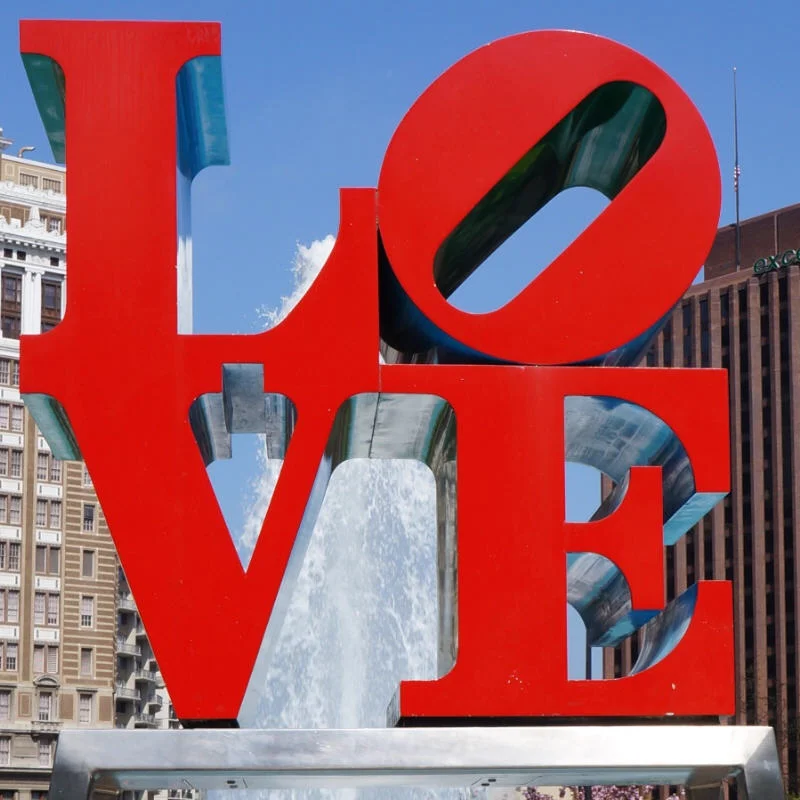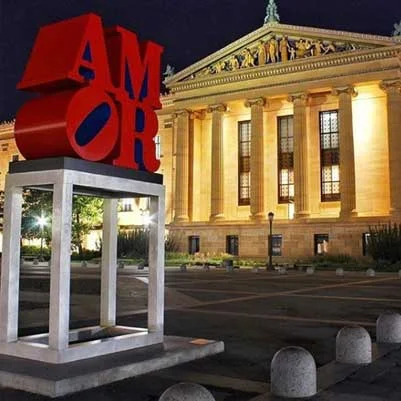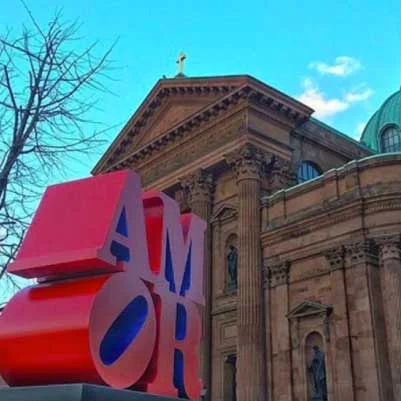What is LOVE?
Andrea Duffie
Love has long been the subject of art, music, literature, and theatre ever since the earliest days of human expression. It's a theme that is so vast, that's revisited so often, that's reinterpreted by so many, that there is no possible way I'd ever be able to do it justice in a single blog post.
But what about the word "love" as a work of art?
While I was running around Philadelphia during my very first Museumpalooza (ah, memories!), I stumbled upon this elevated sculpture by Robert Indiana in John F. Kennedy Plaza, now known affectionately as "Love Park". You may have seen similar sculptures in other large U.S. cities, like New York or Indianapolis, but at the time, I really didn't know much about it.
Begging the question...what is LOVE?
"Baby, don't hurt me...don't hurt me...no more."
LOVE IS...A CHRISTMAS CARD.
Turns out, Robert Indiana's most famous work of art didn't start out as a celebration of Valentine's Day – it celebrated a holiday that took place a few months earlier.
LOVE actually started out as a Christmas card, specially commissioned by MoMA in 1965. It would go on to become the most popular Christmas card that the museum had ever issued.
The design had a variety of personal influences for Indiana. Growing up in the Christian Science Church, he wasn't exposed to much traditional religious iconography – no crosses, crucifixes, or saints. Instead, the message of the Christian Science Church was simple: love.
And as for the colors? Indiana was encouraged in his artistic pursuits by his father, who worked for the Phillips 66 gasoline company. Although his father passed away in 1965, while Indiana was working on this piece, the artist fondly remembered seeing the red and green Phillips 66 sign as a kid, contrasted against the blue sky. Thus, the color palette for the original piece was born.
LOVE IS...A MOVEMENT.
Once it was created, Indiana's LOVE quickly became assimilated into pop culture. After all, the counterculture movement was at its peak by the mid-1960s; "free love" and social revolution was in the air.
There was also plenty of violence in the world and much to rebel against – the loss of American lives during the Vietnam War, police brutality against homosexuals during the Stonewall Riots, violence against people of color during the Birmingham Riot and subsequent battles for Civil Rights, and the assassinations of President John F. Kennedy, Dr. Martin Luther King, Jr., and Robert Kennedy.
So it made sense that Indiana's LOVE became popular. As art historian John Wilmerding notes, "It has power both for its graphics and for its meaning. You can see it against the background of the Cold War as if it were a wish for peace, a wish for brotherly love, easily associated with a pervasive American phenomenon going back to the Kennedys."
LOVE IS...PROBLEMATIC.
The popularity of the LOVE design soon began causing its own set of issues, mostly surrounding copyright. Prior to 1978, U.S. copyright law stated that in order for a creation to be protected, an artist had to either register it or put a copyright notice on it.
Indiana failed to copyright his LOVE design at the time, so this meant that there was little he could do to stop the many unauthorized uses and knock-offs of his art – not to mention the amount of royalties he missed out on. Of particular note is the popular LOVE postage stamp, issued by the U.S. Postal Service in 1973 – over 300 million stamps were printed, and Indiana only received a one-time flat fee of $1,000.
Once a new copyright law went into effect in 1978, it no longer became necessary for an artist to place a copyright notice on his work to receive royalties from its use. Since then, Indiana has been able to reclaim his rights to his LOVE design.
LOVE IS...UNIVERSAL.
By 1977, Indiana started translating his LOVE design into other languages. His first translation, AHAVA (1977) means "love" in Hebrew. After being exhibited in Central Park, the piece was gifted to the Israel Museum in Jerusalem.
Due to the positions of the letters, the piece takes on new meaning when written in Hebrew, explains Mira Lapidot, the Chief Curator of Fine Arts at the Israel Museum:
"If you cross it horizontally, you have the word "love" like you have it in English. But vertically, it could also be read as two different Hebrew words. You have 'av', which is the Hebrew word for father; then you have the double 'hay', which is an acronym or a symbol for God. So suddenly you have 'God the father,' which is interesting because it goes back to why Indiana began his engagement with the LOVE logo – 'God is love' from the Christian Science Church."
Another example of Indiana's translated LOVE designs is AMOR (1998) – which means "love" in both Spanish and Latin. This particular sculpture spent a year on the east terrace of the Philadelphia Museum of Art, where it served as a backdrop for the 2015 World Meeting of Families and a public mass led by Pope Francis during his papal visit to the city.
The sculpture has since moved down the street, and can now be found in Sister Cities Park...still looking right at home in the City of Brotherly Love.






